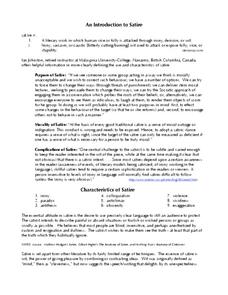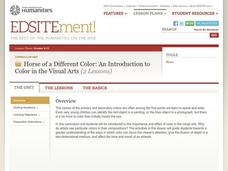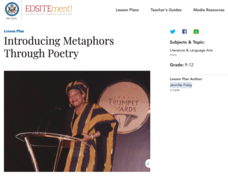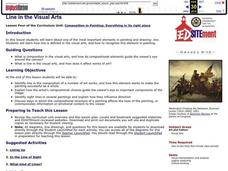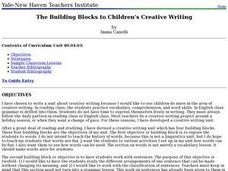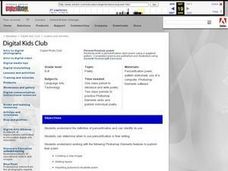Jackson School District
An Introduction to Satire
What is satire, and what are its characteristics? A handy handout provides young satirists with all the information they need to analyze a satire or to craft their own.
Teach With Movies
The Great Gatsby
Are you thinking about incorporating a film version of F. Scott Fitzgerald's classic novel in a study of The Great Gatsby? Check out a guide loaded with suggestions for how to supplement a reading of the novel with scenes from three film...
Academy of American Poets
Voice
Four lessons make up a poetry unit that introduces high schoolers to spoken and written poetry. Class members also examine poems as social commentary and connect these poems to various novels and plays. A great way to incorporate poetry...
National Endowment for the Humanities
Magical Elements in Magical Realism
How does Gabriel Garcia Marquez make the magical elements of his novel appear so real? That's the challenge facing readers of One Hundred Years of Solitude. Scholars examine the tone and descriptive details Garcia Marquez uses to...
K20 LEARN
The Most Dangerous Game
Readers of "The Most Dangerous Game" must argue which of Richard Connell's characters is the protagonist or antagonist. The lesson plan begins with scholars reading selected passages from the story and making predictions about who they...
Utah Education Network (UEN)
8th Grade Poetry: Sonnet Poem
The third lesson of five in an eighth-grade poetry unit has young scholars comparing Shakespearean sonnets with Petrarchan sonnets. To begin, they examine the different structures of the two forms and their different rhyme schemes. After...
Texas Education Agency (TEA)
Annotate and Analyze a Paired Passage: Practice 1 (English II Reading)
What do a colt and a boy in a tree have in common? More than might be first apparent. The fourth interactive in a series of ten introduces readers to intertextuality, the process of using abstract thinking to consider how one text...
Curated OER
Metaphor and Metonymy
If you are teaching metaphors in your language arts class, consider using this presentation to illustrate several examples of classic metaphors. Body metaphors, war metaphors, and comic metaphors all help learners understand the...
Curated OER
Identifying, Mapping, and Personifying Countries Involved in WWII
Get artsy with this WWII group activity, starting with a whole-class assignment. Create a map of Europe, Northern Africa, and the Pacific using geometric shapes cut from construction paper and placed on the floor. Consider splitting the...
Curated OER
Horse of a Different Color: An Introduction to Color in the Visual Arts
Students identify ways in which the artist uses color to draw the view's attention to points within the composition and creates a sense of depth. They discuss the effect of color on the tone and mood of an artwork.
Curated OER
A Study of Warm And Cool Colors
Second graders create a multimedia painting using warm or cool colors expressively. They demonstrate multimedia techniques in a drawing using pencil, oil pastel and tempera paints. They recognize and discuss mood created by warm and cool...
Curated OER
Silent Movies: A Year 7 Scheme of Work
Even an outline can give you enough information to execute an awsome project. The tasks for each of the seven weeks of this project are defined, as well as the objective and specific content facilitated through the project. Learners will...
Curated OER
Animal Self-portrait Mosaics: A Visual Arts Elective
Out-lined here is a two-week procedure that has the class creating ceramic animal tiles that are metaphorical representations of their own personalities. They discuss animal images found throughout history, what they mean, metaphor, and...
Curated OER
Chasing Metaphors
Students use metaphors in order to see commonly experienced objects, events, and people in new and more meaningful ways.
Curated OER
Horse Character: Ceramics Lesson
Animals oftentimes elicit various characteristics which make them symbolic or representative of human feeling, action, or emotion. The class creates horse characters out of clay to show character action and symbolism. This is a great...
National Endowment for the Humanities
Introducing Metaphors Through Poetry
Metaphors are word pictures, creating images in our brains that draw readers to consider how two seemingly unrelated items are alike. Poems by Langston Hughes, Margaret Atwood, and Naomi Shihad Nye provide learners with an opportunity to...
Curated OER
Follow the Leader: Line in the Visual Arts
Young scholars explore line in painting and drawing and examine how it is defined in the visual arts. Recognizing line in the composition of a number of art works and how it affects these works of art is the focus of this lesson plan.
Curated OER
In Depth with the Full Spectrum
Students explore the basic color wheel and the ways that artists use color to guide the viewer's attention through a painting's composition. A creation of a sense of depth in a two dimensional space and the effect of color on mood and...
Curated OER
Pen and Ink Drawing
Learners hone their drawing techniques to create a nature-inspired piece of art. They practice hatching, cross hatching, stippling, and shading. They discuss how each method is better suited for creating specific elements in nature such...
Curated OER
Creative Writing: Children's Building Blocks
Your class can participate in a writing program involving four building blocks. By exploring words, sentences, writing forms, and story organization, they improve their creative writing skills throughout this year-long unit. Early in the...
Curated OER
Personification Poem
Students write a personification poem and identify its use. They make a pattern worksheet and then use Photoshop Elements skills to illustrate their poem. Students use layer styles with the text to highlight the poetry.
Curated OER
You Have Egg On Your Face
Students explore and analyze how the human face is proportioned and explore ways artists use mathematics to make art. They demonstrate the basic face proportions by creating a reference sketch and illustrating visual clues to communicate...
Curated OER
Lesson Plan for C.S Lewis’ The Magician’s Nephew
Here is a lesson that incorporates music writing, and reading literature. The class reads chapter eight from the C.S. Lewis classic The Magician's Nephew. Then, just like in the story, they use music as inspiration to create (write)...
Curated OER
Fall Similes
Fall is like a beautiful painting come to life—or is it more like an overflowing cornucopia? Practice writing similes with a lesson on figurative language. As learners review simile structure, they come up with their favorite similes for...
Other popular searches
- Teaching Literary Devices
- Literary Devices and Terms
- Literary Devices & Quotes
- Common Literary Devices
- Literary Devices and Reading
- Introducing Literary Devices
- Literary Devices Irony
- Glossary of Literary Devices
- Literary Devices Inkheart
- Literary Devices Music
- Literary Device Flashback
- Ell Literary Device Activity


